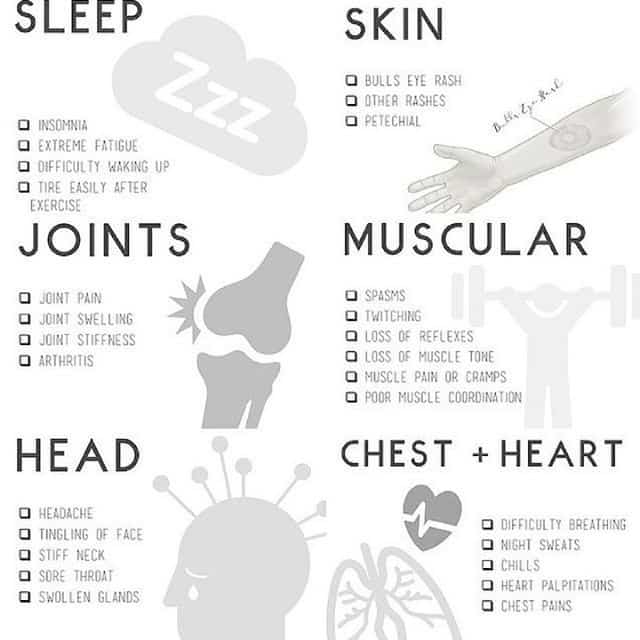Early Symptoms Of Lyme Disease
Early symptoms will typically develop 1 to 4 weeks after being bitten, however, they can appear anytime between 3 to 30 days after exposure.
Many people with early-stage Lyme disease develop a distinctive circular red rash usually, but not always, at the site of the tick bite.
The rash is often described as looking like a bulls-eye on a dart board and is known as erythema migrans. The affected area of skin will be red and the edges may feel slightly raised.
The size of the rash can vary significantly and it may expand over several days or weeks. Typically, its around 15cm across but it can be much larger or smaller than this.
Some people may develop several rashes on different parts of their body. However, around one in every 3 people with Lyme disease do not report seeing a rash.
As well as a rash, people with early Lyme disease may experience any of the following:
- flu-like symptoms such as fever and sweats, chills, fatigue, neck pain or stiffness, headaches, joint or muscle pains
- paralysis of the facial muscles, typically only on one side of the face
- nerve pains, which may be shooting, sharp or prickly and which follow the course of the nerve
Can Lyme Disease Be Treated
In most cases, yes. Antibiotics can effectively treat Lyme disease, especially when treatment begins early. Cases that reach the later stages of the disease, however, can be difficult to treat and some symptoms can persist.
PHAC reports that removing the tick within 24-36 hours usually prevents infection.
How Are Dogs Tested For Lyme Disease
Diagnosis is made by a combination of history, physical signs, and diagnostics. For dogs, the two blood tests for diagnosing Lyme disease are called the C6 Test and Quant C6 test. Veterinarians perform both.
The C6 test detects antibodies against a protein called C6. Presence of the antibodies suggests an active Lyme infection. The C6 antibodies can be detected three to five weeks after an infected tick bites a dog and may be found in the bloodstream even before the dog shows signs of illness.
The next step is to do a Quant C6 test. This, along with urinalysis will help determine if antibiotic treatment is necessary.
Read Also: Select Physical Therapy Old Lyme
Early Localized Lyme Disease
Early localized disease, the initial manifestation, begins between three and 30 days after a bite. It is characterized by:
- Bullseye rash and swelling,the most notorious symptom, occurs in 70% to 80% of cases. Clinically referred to as erythema migrans, its appearance variesit can be a different color or shapeespecially in people of color. It arises about a week after exposure to the bacteria.
- Other symptoms of the first stage include fever, fatigue, headache, and joint pain. Very often, those with the conditionespecially if there is no rashfeel as if theyre experiencing the flu.
What Are The Stages Of Lyme Infection

There are three stages:
- Early localized Lyme: Flu-like symptoms like fever, chills, headache, swollen lymph nodes, sore throat, and a rash that looks like a bull’s-eye or is round and red and at least 2 inches long
- Early disseminated Lyme: Flu-like symptoms like pain, weakness, or numbness in your arms and legs, changes in your vision, heart palpitations and chest pain, a rash , and a type of facial paralysis known as Bellâs palsy
- Late disseminated Lyme: This can happen weeks, months, or years after the tick bite. Symptoms might include arthritis, severe fatigue and headaches, dizziness, trouble sleeping, and confusion.
About 10% of people treated for Lyme infection donât shake the disease. They may go on to have three core symptoms: joint or muscle pain, fatigue, and short-term memory loss or confusion. This is called post-treatment Lyme disease syndrome. It can be hard to diagnose because it has the same symptoms as other diseases. Plus, there isn’t a blood test to confirm it.
Experts arenât sure why Lyme symptoms donât always go away. One theory is that your body keeps fighting the infection even after the bacteria are gone, like an autoimmune disorder.
You May Like: How Fast Does Lyme Disease Show Up
Lyme Disease From Nymphs
Come fall, larvae grow to poppyseed sized nymphs.
Nymphs remain inactive throughout the winter and early spring. In late spring, the nymph will begin looking for a host. Once a nymph finds a host, it will latch on for four or five days. It will engorge with blood and swell to several times its original size.
- If infected in the larval stage, the nymph may give Lyme disease to its host.
- If the nymph was not infected as a larva but the host is, the nymph will become a carrier.
in endemic areas of the northeast and upper midwest, up to 25% of nymphs carry the Lyme disease spirochete.
Like tick larvae, nymphs prefer small mammals and birds but your dog can be a suitable substitute.
Nymphs are also the most dangerous. Heres why
To give Lyme disease to your dog, ticks must feed for 24 to 36 hours. If you remove them before this time, theyre unlikely to transmit the disease. But because nymphs are so small, they often go unnoticed until theyre engorged. This makes the nymph most likely to spread Lyme disease. .
Once engorged, the nymph will drop off its host and molt into an adult in the comfort of fallen leaves.
How Do I Know If I Have A Tick Bite
Many people who develop the disease do not remember seeing ticks or being bitten. Tick bites commonly occur from May to September in North America, although blacklegged ticks can be active most of the year. Ticks sometimes move around on the body but they usually attach themselves to the skin and stay in one place. Before feeding, ticks look like small, brown scabs or freckles. After feeding, ticks may swell considerably, and could be as big as a raisin or a small grape.
Follow the link for more information about blacklegged ticks from the Government of Canada.
Read Also: What Are Tests For Lyme Disease
Lyme Disease In Dogs: What Your Vet Isnt Telling You
Lyme disease the mere thought of it is terrifying to pet owners everywhere. Rashes, lameness, swollen joints these are all symptoms that you never want your dog to experience.
The good news is, the situation isnt as scary as you may have thought.
Before we look at why, lets take a look at how dogs get Lyme disease in the first place.
Who Gets Lyme Disease
Anyone bitten by an infected deer tick can get Lyme disease. Most U.S. cases of Lyme disease happen in Connecticut, Delaware, Maine, Maryland, Massachusetts, Minnesota, New Hampshire, New Jersey, New York, Pennsylvania, Rhode Island, Vermont, Virginia, and Wisconsin. But Lyme disease is also found in other parts of the U.S., Europe, and Asia.
Other things that might increase a person’s risk include:
- spending a lot of time outdoors in tall grass, brush, shrubs, or wooded areas
- having pets that may carry ticks indoors
- activities such as yardwork, hiking, camping, fishing, or hunting in tick-infested areas
Also Check: Lyme Disease High Blood Pressure
What Causes Lyme Disease
Lyme disease is carried by the blacklegged tick, also known as the deer tick. This tick is found in the northeastern and upper midwestern United States. On the Pacific coast, Lyme disease is spread by the western blacklegged tick .
When an infected tick bites you, a bacteria called Borrelia burgdorferi passes from the tick into your bloodstream. In order for this to happen, the tick must be attached to you for 36 to 48 hours. Most people are infected when they’re bitten by immature ticks, which can be difficult to see.
Stage : Late Disseminated Lyme Disease
Late disseminated Lyme disease occurs when the infection hasnt been treated in stages 1 and 2. Stage 3 can occur months or years after the tick bite.
This stage is characterized by:
- arthritis of one or more large joints
- brain disorders, such as encephalopathy, which can cause short-term memory loss, difficulty concentrating, mental fogginess, problems with following conversations and sleep disturbance
- numbness in the arms, legs, hands, or feet
Read Also: Ticks That Carry Lyme Disease Picture
Don’t Miss: Herbs That Kill Lyme Disease
How Can I Safely Treat Lyme Disease While I’m Pregnant
Getting diagnosed early on is key so that the antibiotics can start to work on the disease, and you can avoid the more serious, later stage complications.
Lyme disease can be safely treated when you’re pregnant with antibiotics like amoxicillin.Trusted SourceCenters for Disease Control and PreventionPregnancy and Lyme DiseaseSee All Sources While doxycycline is an effective treatment for Lyme disease, it is not considered safe during pregnancy. Azithromycin also may not be safe to take.
How Do You Get Rid Of Chronic Lyme Disease

Although most cases of Lyme disease can be cured with a 2- to 4-week course of oral antibiotics, patients can sometimes have symptoms of pain, fatigue, or difficulty thinking that lasts for more than 6 months after they finish treatment. This condition is called Post-Treatment Lyme Disease Syndrome .
Read Also: How Does Lyme Disease Spread
Lyme Disease Vs Ringworm
Erythema migrans can often be mistaken for other kinds of rashes. Since not all rashes are the same, they need to be examined and evaluated carefully. The rash from ringworm, for example, looks very similar to a Lyme disease rash because it also has a circular shape. The only difference is that the Lyme disease rash is clear in the middle, while the ringworm rash is red and scaly.
The rash from Lyme disease may also be accompanied by general symptoms of infection, including:
- Fever and chills
- Swollen lymph nodes
- Physical fatigue
These symptoms usually occur within the first 3 to 30 days after getting bitten by a tick .
Can Lyme Disease Be Prevented Or Avoided
The best way to prevent Lyme disease is to avoid being bitten by ticks. When you are outdoors, follow these guidelines:
- Avoid areas that are wooded, brushy, or have tall grass.
- Walk in the center of trails.
- Use an insect repellent with at least 20% DEET. It can be put on clothing or sparingly on the skin. Dont apply it to the face or hands of children.
- Treat clothing, tents, or other gear with repellents containing 0.5% permethrin.
- Wear light-colored clothing. This makes it easier to see and remove ticks from your clothes.
- Wear a long-sleeved shirt and long pants. Tuck your pant legs into your socks or boots for added protection.
After you get home, check everything and everyone for ticks.
- Bathe or shower as soon as you can to wash off any ticks that have not attached to you.
- Check your entire body for ticks. Use a mirror for places you cant see. Check your children and your pets. Common tick locations include the back of the knees, groin area, underarms, ears, scalp, and the back of the neck.
- Check any gear you used, including coats, backpacks, or tents.
Tumble dry clothes or blankets on high heat in the dryer for 10 to 15 minutes. This should kill any ticks. If clothes are dirty, wash them in hot water and dry on high heat for 60 minutes.
Don’t Miss: Lyme Disease Specialist Tampa Fl
What Are The Signs & Symptoms Of Lyme Disease
Lyme disease can affect different body systems, such as the nervous system, joints, skin, and heart. The symptoms of Lyme disease are often described as happening in three stages. Not everyone with Lyme has all of these, though:
The rash sometimes has a bulls-eye appearance, with a central red spot surrounded by clear skin that is ringed by an expanding red rash. It also can appear as an growing ring of solid redness. Its usually flat and painless, but sometimes can be warm to the touch, itchy, scaly, burning, or prickling. The rash may look and feel very different from one person to the next. It can be harder to see on people with darker skin tones, where it can look like a bruise. It gets bigger for a few days to weeks, then goes away on its own. A person also may have flu-like symptoms such as fever, tiredness, headache, and muscle aches.
Lyme Disease: More Common And More Dangerous Than You Think
Lyme disease outbreaks are already being reported this spring, and experts say theres a long way to go before we grasp the scope and impact of this serious tick-borne illness.
In the early 1990s, Dr. Neil Spector began experiencing odd symptoms.
At times, his heart would beat 200 times a minute. He also suffered crippling fatigue and had brain fog so intense he once gave a lecture and had no recollection of it.
Blood tests showed his body was producing high levels of antibodies, but specialists couldnt determine what was triggering his immune systems response.
It said my body was mounting a defense against something, Spector told Healthline. They just kept chalking it up to stress.
More symptoms began appearing slow heartbeat, arthritis pain, and burning in his heels but experts dismissed Spectors theory that they could be signs of Lyme disease, the most common vector-borne infection in humans.
Spectors symptoms began right after he moved from Boston to Miami, but Lyme disease is uncommon in Florida. Spector said he doesnt remember ever having the trademark bulls-eye rash of Lyme disease.
Spector, an associate professor of oncology at the Duke University School of Medicine, had no formal training in Lyme disease, but that changed as he searched for an explanation for his symptoms.
I dont think I have Lyme disease anymore, but the damage to my heart was already done by the time I was diagnosed, he said.
You May Like: Lyme Disease And Joint Pain
Don’t Miss: How Much Is A Lyme Disease Test
What Happens At Your Appointment
The GP will ask about your symptoms and consider any rash or recent tick bites you know about.
Lyme disease can be difficult to diagnose. It has similar symptoms to other conditions and there’s not always an obvious rash.
2 types of blood test are available to help confirm or rule out Lyme disease. But these tests are not always accurate in the early stages of the disease.
You may need to be retested if you still have Lyme disease symptoms after a negative result.
Testing For Lyme Disease Antibodies
Most general practitioners follow the Center for Disease Controls two-step protocol to test for Lyme disease. Some doctors will test you immediately, and some will wait a few weeks to ensure your body has time to develop antibodies to Lyme bacteria. If antibodies are not detected, your test will be negative. An extremely high percentage of people tested for Lyme disease receive a false negative result.
This result happens for several reasons. Lyme bacteria can go dormant or inactive, evading detection. They can also hide inside the lining and walls of tissues and cells, receiving protection from detection. They can even protect themselves by building biofilms that act as shields. If you receive a negative result but have symptoms, getting a second opinion from a Lyme-literate doctor specializing in infectious diseases is crucial.
Read Also: Homeopathic Protocol For Lyme Disease
How Do I Remove A Tick
You should know how to remove a tick just in case one lands on you or a friend. To be safe, remove the tick as soon as possible.
If you find a tick:
- Use tweezers to grasp the tick firmly at its head or mouth, next to your skin.
- Pull firmly and steadily on the tick until it lets go of the skin. If part of the tick stays in your skin, don’t worry. It will eventually come out. But call your doctor if you notice any irritation in the area or symptoms of Lyme disease.
- Swab the bite site with alcohol.
Note: Don’t use petroleum jelly or a lit match to kill a tick. They won’t get the tick off your skin quickly enough, and may just cause it to burrow deeper into your skin.
When To See Your Gp

You should contact your GP or dial NHS 111 promptly if you feel unwell with any of the symptoms described above after being bitten by a tick or after spending time in areas where ticks may live.
Take this leaflet with you if you are unsure what to say and remember to let your GP know if youve recently had a tick bite or spent time in areas where ticks may live.
Diagnosing Lyme disease can be difficult as many of the symptoms are similar to other conditions. A spreading erythema migrans rash appearing some days after a known tick bite is characteristic and should be treated with antibiotics.
If you dont have this rash but do have other symptoms of Lyme disease, blood tests can be carried out that look for antibodies against the borrelia bacteria.
Blood tests can be negative in the early stages of the infection as the antibodies take some time to reach levels that can be detected.
You may need to be re-tested if Lyme disease is still suspected 4 to 6 weeks after a first negative test result.
If you have long-lasting symptoms, you may be referred to a specialist in microbiology, infectious diseases, rheumatology, or neurology as appropriate for further investigation and management.
Read Also: Can Lyme Disease Cause Seizures